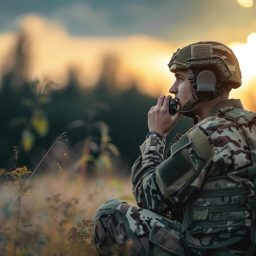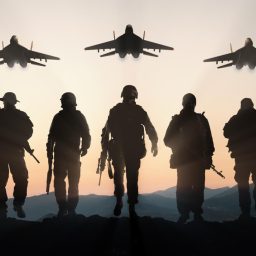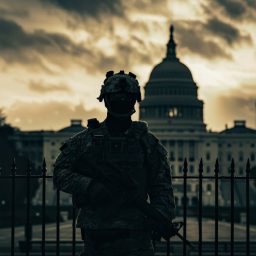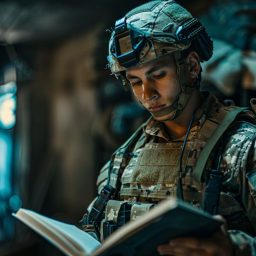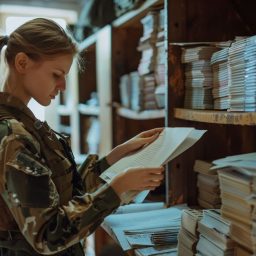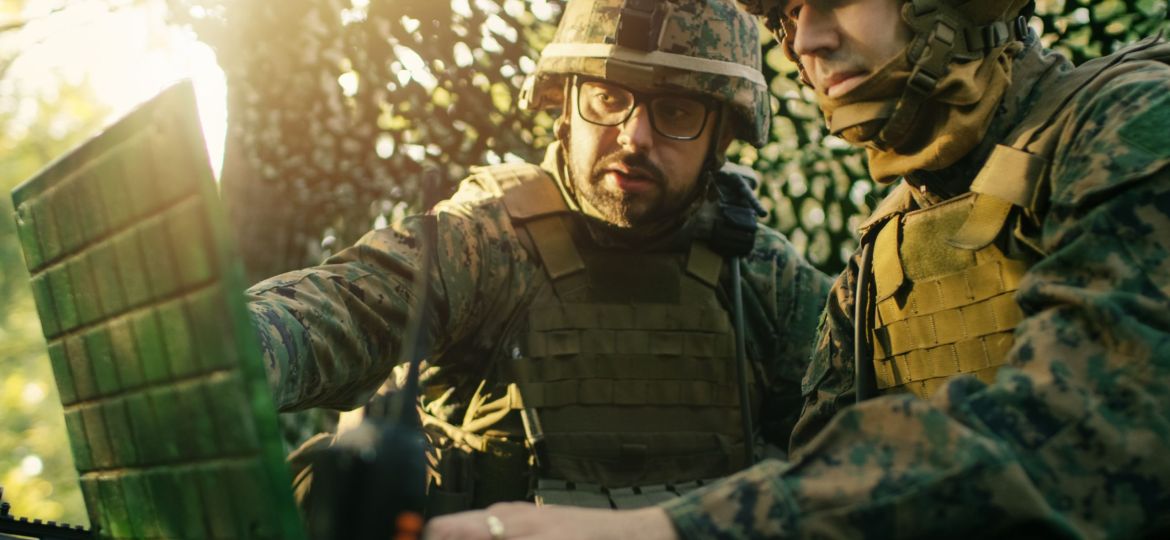
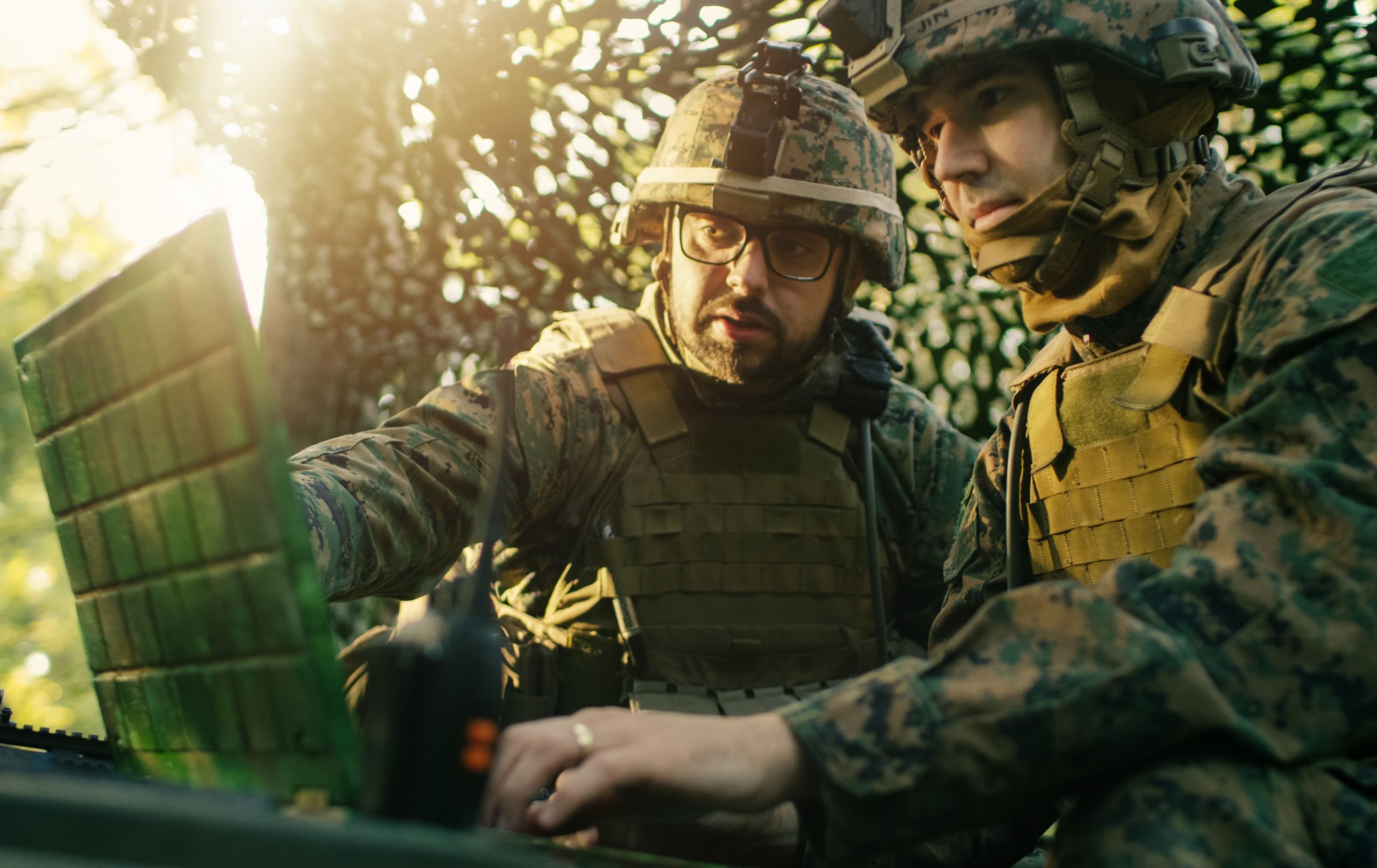
How significant are words in the military? The language used by the armed forces is more than just a collection of technical terms.
Military terminology is a code that simplifies understanding past conflicts and current military operations. It is a mode of communication that helps to understand military operations and gain a more in-depth insight into history. What does a military slang sound like? We have prepared a small knowledge base for you.
Contents
Why is it worth knowing military terms?
Knowledge of military terminology is useful far beyond the confines of training ranges and headquarters. Why should the average person know what “suppressive fire” or “reconnaissance” is? The answer is simple. We live in a world where we encounter conflicts at every turn. News about global tensions, action movies, and even video games are saturated with military language.
Understanding military terms will broaden your perspective. When you see this as more than just a mysterious code, you will understand international diplomacy, and even team sports better (yes, team sports also draw from tactical principles borrowed from military tactics).
Types of military service in the United States
In the United States, military service is integral to the nation’s defence system, governed by specific legal regulations.
Unlike some countries where conscription is a mandatory obligation, the U.S. shifted to an all-volunteer force in 1973. This means that, currently, the majority of U.S. citizens are not required to serve in the military in the traditional sense. Individuals who want to pursue a professional military career, need to apply for that.
However, U.S. citizens are still obligated to register with the Selective Service System. Individuals can be conscripted if a national emergency requires rapid expansion of the armed forces. With that in mind, the U.S. government offers various training and preparatory programs, available to citizens, which prepare them for potential military service.
Basic military concepts
To understand how an army operates as a whole, it is essential to familiarise yourself with its structure: the various operational and tactical groups, units, and subunits.
Army
An army is a large military formation. It comprises various types of units: infantry, artillery, cavalry (in a historical context), and other support units. The size and structure of an army vary significantly from country to country.
Armies are responsible for conducting large-scale military operations, both in defence of their country and abroad. They may include several corps and divisions, enabling them to carry out complex operations on a broad scale. An army is commanded by a high-ranking officer, often a general.
The term “army” is typically used synonymously with a nation’s entire armed forces. This includes land forces, air forces, naval forces, and special forces.
Corps
A corps is a large military unit composed of divisions commanded by a general. It executes large-scale military operations, combining different forces to achieve strategic objectives.
A defining feature of a corps is the integration of various types of forces: infantry, artillery, military engineering, and sometimes even air units or other specialised groups. This enables the corps to conduct complex military operations, making the most of its resources.
Division
A division is a large military unit, typically comprising 10,000 to 25,000 soldiers. It is a complex formation that combines various types of units: infantry, artillery, and even support. Within a division, there are several brigades and regiments. When they work together, they form a formidable fighting force. Divisions, commanded by generals, play a pivotal role in large-scale military operations.
Regiment
A regiment in the army is a military unit, often consisting of several battalions and typically commanded by a colonel. The size of a regiment varies. It generally ranges from a few hundred to a few thousand soldiers. Regiments are important in military tradition and heritage, typically having their distinctive history, uniforms, and insignia.
In terms of structure, a regiment includes various subunits, such as infantry, artillery, or cavalry, depending on its designated role within the army. The regiment serves as a key tactical unit on the battlefield, capable of operating independently or as part of a larger brigade or division. The system is renowned for fostering a strong sense of camaraderie and unit pride among its members, which is considered beneficial for morale in military operations.
Battalion
A battalion is a fundamental tactical unit in many armies, forming the building blocks of a larger military structure. A battalion typically consists of 300 to 1000 soldiers and often belongs to a larger group. It is divided into companies and smaller support subunits. The battalion is usually commanded by an officer with the rank of major or lieutenant colonel.
Company
A company comprises approximately 100 to 250 soldiers, non-commissioned officers, and officers. It is often divided into platoons. The formation is responsible for executing specific tasks on the battlefield. It is led by an officer with the rank of major or captain.
Platoon
A platoon is a smaller military unit, typically consisting of up to 100 people. It typically serves as the basic element of a company and specialises in various fields, such as infantry, artillery, or engineering. The platoon commander, often a lieutenant, needs to be capable of rapid response in combat situations.
Squad
A squad is a very small unit, comprising a few soldiers specialised in specific tasks. In infantry, it may be responsible for combat duties: patrolling, securing terrain, or engaging directly with the enemy.
Squads are also assigned specific functions related to equipment operation. They perform certain technical tasks or support other units.
The squad implies close involvement of its members in both combat actions and daily training. Due to its small size, there is typically a tight bond and a high level of trust among the soldiers. Each member must thoroughly understand their roles and tasks to function as a team.
The US military forces rank structure
In the United States Army, the rank structure is a precisely organised system that delineates the hierarchy within the military. These ranks fall into three main categories: commissioned officers, warrant officers, and enlisted personnel.
Commissioned officers
These ranks start with Second Lieutenant and ascend to First Lieutenant, Captain, Major, Lieutenant Colonel, and Colonel.
At the apex are the general officer ranks: Brigadier General, Major General, Lieutenant General, and General, with the highest being General of the Army, a rank that is rarely bestowed and typically only in wartime.
Commissioned officers are responsible for leading and managing soldiers, making strategic decisions, and maintaining the Army’s operational capabilities.
Warrant officers
Warrant officers are highly specialised experts and trainers in their military occupational specialities. Their ranks include Warrant Officer 1, Chief Warrant Officer 2 through 5.
They provide technical and tactical leadership, particularly in areas like aviation, intelligence, and engineering.
Enlisted Personnel
The backbone of the Army, enlisted ranks range from:
- Private,
- Private First Class,
- Specialist/Corporal,
up through the non-commissioned officer (NCO) ranks of:
- Sergeant,
- Staff Sergeant,
- Sergeant First Class,
- Master Sergeant,
- First Sergeant,
- Sergeant Major,
- Command Sergeant Major,
to the highest enlisted rank, Sergeant Major of the Army.
Enlisted soldiers perform the primary tasks of the military, and NCOs serve as the primary leaders and trainers of enlisted soldiers, responsible for their welfare, discipline, and professional development.
The U.S. Army’s rank structure reflects the level of responsibility, leadership, and expertise required at each level. Progression through the ranks is based on time in service, job performance, and completion of required training and education.
How can you identify various ranks in the U.S. Army?
To recognise a soldier’s rank in the U.S. Army, look for insignia worn on their uniform, particularly on shoulder boards, chest, headgear, and sleeves. The design of these insignia varies slightly between the Army, Air Force, and Navy.
For enlisted personnel, ranks are indicated by chevrons and rockers worn on the sleeve. Privates and Specialists have distinctive symbols, with increasing numbers of chevrons and rockers as one moves up through the ranks to Sergeant Major. In the U.S. Army, the highest enlisted rank, Sergeant Major of the Army, has a unique insignia featuring three stars.
Commissioned officers’ insignias are typically gold or silver bars, oak leaves, eagles, or stars worn on shoulder boards or lapels. A Second Lieutenant starts with a single gold bar, progressing up to a full Colonel with a silver eagle. General officer ranks are denoted by stars, from one star for a Brigadier General to four stars for a full General.
Warrant Officers wear insignia that is a mix of bars and squares. They start with one silver bar with black squares for Warrant Officer 1 and progress through to Chief Warrant Officer 5, which is indicated by a silver bar with five black squares.
Each service branch has its specific variations of these insignia. For example, in the Navy, enlisted personnel use stripes and rate badges, while officers have different styles of stars and stripes.
It is important to note these variations when identifying ranks across different branches of the U.S. military.
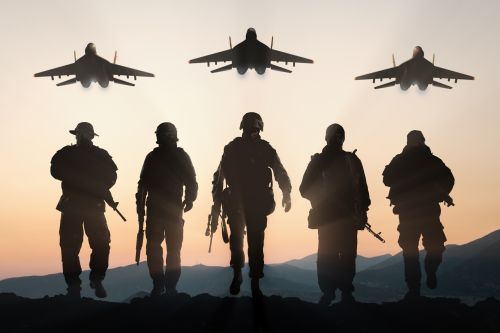
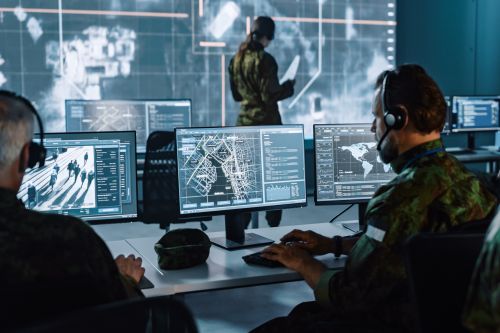
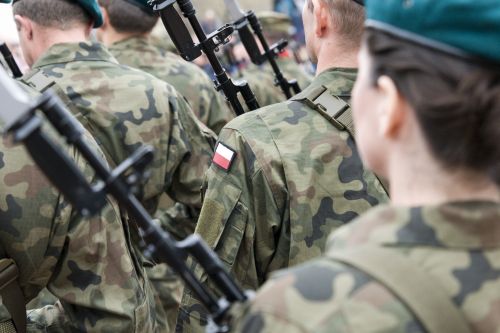
Operational Terms
Get acquainted with the language used by military personnel during the planning and execution of operations. Learn the most popular operational terms.
Attack
An attack is a basic offensive action aimed at defeating and dominating the opponent. It can take various forms: a frontal assault, flanking manoeuvre, aerial warfare, or amphibious warfare.
An attack typically includes the element of surprise, concentrated fire, and rapid seizure of strategic terrain points.
Defence
Defence is an action counter to attack. Its objective is to hold positions and protect strategic areas from the enemy. Defence can be passive or active, the latter involving counterattacks to disrupt enemy forces.
Effective defence requires well-prepared positions, coordination between units, and maintaining high morale among soldiers.
Reconnaissance
Reconnaissance aims to gather information about the enemy and terrain. It enables the planning of effective offensive or defensive actions. Reconnaissance is conducted by specialised scout units, drones, satellites, or advanced electronic systems. The accuracy of reconnaissance often determines the success of an entire military operation.
Ambush
An ambush involves hiding forces and unexpectedly attacking the enemy when they enter a specified zone. This tactic utilises the element of surprise, reduces the risk to the attackers, and increases enemy casualties.
Pincer movement
A pincer movement is a type of offensive manoeuvre. Attacking units move to surround the enemy from two sides simultaneously. The goal is to cut off the enemy from their supply lines or retreat routes, especially when the opponent moves toward the centre of the army.
Airdrop
An airdrop involves transferring soldiers, equipment, and supplies to the enemy’s rear or a specific point, typically using aeroplanes or helicopters. This operation allows for the rapid securing of strategic points and the establishment of a foothold for further operations.
Suppressive fire
Suppressive fire involves the use of artillery or other heavy weaponry to create a fire barrier that impedes enemy movements. It is used to cover one’s movements or to facilitate a withdrawal. This tactic is essential in both offensive and defensive operations, as it prevents the enemy from advancing. The manoeuvre disrupts their formations, or forces them into cover, gaining a tactical advantage.
Medical evacuation
Medical evacuation, commonly referred to as medevac or medivac, is the process of rapidly transporting injured or sick soldiers from the battlefield to a location where they receive full medical care.
Medevac is carried out using various means of transportation, including helicopters, ambulances, or even fixed-wing aircraft, depending on the urgency and the environment of the operation. The speed of medical evacuations is vital in saving the lives of wounded personnel.
Equipment and weapon
The equipment and weapons at an army’s disposal often determine the outcomes of battles and entire wars. The quantity, diversity, and incorporation of modern technologies in this equipment favour victory.
Rifle
The rifle is the basic firearm for soldiers, designed for long and medium-range shooting. Modern rifles, such as assault rifles, are equipped with systems that allow for rapid and precise targeting, and offer various firing modes: single shots and bursts. Their effectiveness makes them a staple in modern military operations.
Tank
A tank is a heavily armoured and strongly armed combat vehicle. Used for leading attacks, breaking through enemy defences, and supporting infantry, these machines are equipped with powerful cannons and machine guns. On the battlefield, tanks are known for their high mobility and formidable firepower. They are critical assets in both offensive and defensive operations.
Submarine
Submarines are capable of prolonged underwater navigation and stealth operations. Typically, they are used for reconnaissance missions, as platforms for ballistic or torpedo missiles, and for engaging other naval vessels. Their ability to operate undetected makes them a strategic asset in naval warfare, particularly in controlling sea lanes and conducting covert operations.
Landmine
Minefields serve to block or slow down enemy movements. Modern landmines are detonated through pressure, remotely, or via sensors. They are a significant part of defensive strategies in modern warfare. Barriers protect critical areas or channel enemy forces into predetermined kill zones.
Anti-aircraft defence system
To defend against aerial attacks from aircraft or missiles, anti-aircraft defence systems are used. These include manually operated missile launchers and advanced radar systems. They protect military and civilian targets from aerial threats, ensuring airspace security.
Armoured vehicle
A light armoured vehicle transports soldiers. It is also equipped with weapons for fire support. These machines are faster and more mobile than tanks but offer less protection. They are present in rapid troop deployment and take part in reconnaissance, support, and quick response in combat situations.
Tactical terms
Good strategy is crucial to the outcome of operations. Here are some basic tactical terms that shed light on how armies plan their actions.
Flank
The flank refers to the side of a military formation. Flanking involves attacking from the side rather than head-on. This tactic allows for breaking through an enemy’s defence where their forces are typically less protected on the sides than at the front of the formation.
Breakthrough
A breakthrough is a concentrated attack on a specific segment of the enemy’s defence line. It is employed to create an opening for further offensive action. This tactic requires substantial force, so it is often supported by heavy weaponry, tanks and artillery, to penetrate and disrupt the enemy lines.
Envelopment
Envelopment involves circumventing the enemy’s position and attacking from the rear or side. This manoeuvre works best when a direct attack on the enemy’s position is too risky or challenging. It aims to surprise the enemy, cut off their retreat or supply lines, and confuse their ranks.
Delaying Action
The tactic of delaying action involves intentionally slowing down the enemy’s progress without engaging in full-scale combat. It is used to buy time for the main forces to reorganise or prepare defences. This strategy is often employed when retreating or when it is necessary to hold the enemy until reinforcements arrive or a stronger defensive position is secured.
Military deception
Military deception involves the use of false information to mislead the enemy about one’s intentions. This includes feints or false attacks, using dummy military equipment, or broadcasting misleading radio communications.
The manoeuvre aims to confuse the enemy. When successful, it leads them to allocate resources incorrectly or to prepare for an attack that never comes.
Professional military translations
An accurate understanding of specialised terms helps to perform correct translations for military organisations. Mistakes in translation lead to misunderstandings, which in a military context tend to have serious consequences. Military translations carried out by a professional translation agency guarantee accuracy and fidelity to the source text.
Skrivanek provides the highest quality of service, supported by experts, and translators connected with the defence sector. Contact us to learn more and ensure your military translations are reliable.

